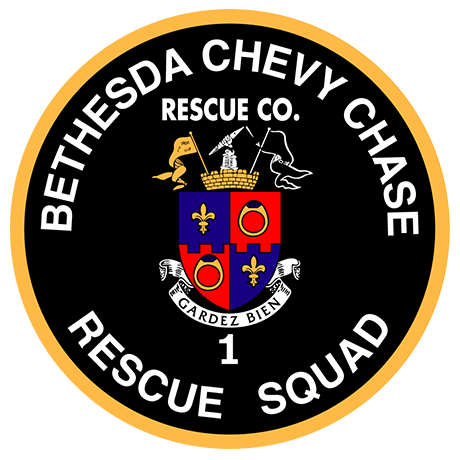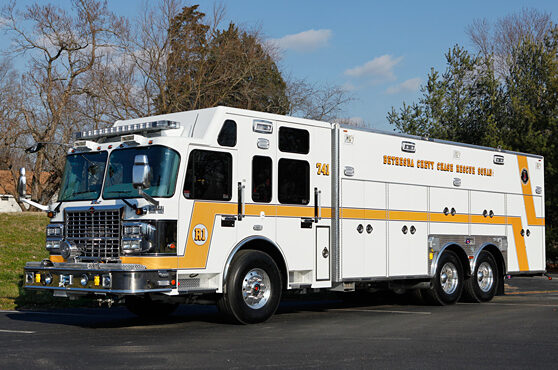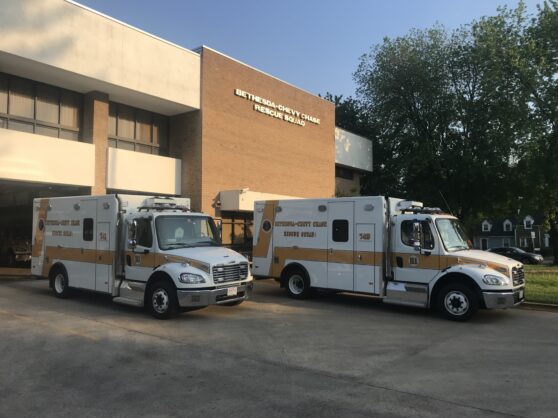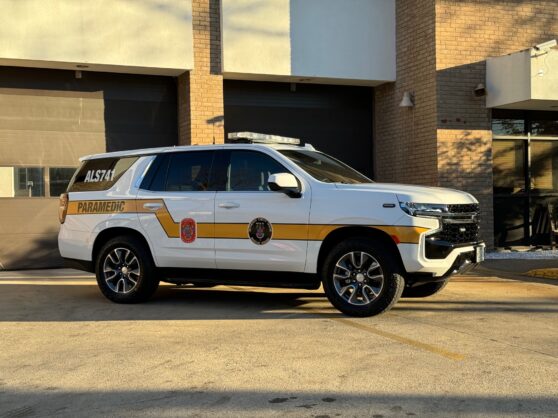The Bethesda-Chevy Chase Rescue Squad has always taken in pride in having state-of-the-art equipment that allows us to offer the highest quality, safest emergency medical and rescue services to our community. Some examples of that equipment include:
 PHYSIO-CONTROL LIFEPAK 15 CARDIAC MONITOR/DEFIBRILLATOR
PHYSIO-CONTROL LIFEPAK 15 CARDIAC MONITOR/DEFIBRILLATOR
The LIFEPAK 15 monitor/defibrillator is one of the most critical medical devices carried by BCCRS paramedics. The LIFEPAK allows them to monitor a patient’s heart rate, oxygen and carbon dioxide levels, blood pressure; it also can be used to perform a 12-lead ECG and transmit it to the doctors at the hospital—potentially saving precious minutes in the treatment of a heart attack victim.
PHYSIO-CONTROL LUCAS II AUTOMATIC CPR DEVICE
Performing chest compressions is one of the most important parts of resuscitating a cardiac arrest victim. Continuous compressions by bystanders can double or even triple a victim’s chance of survival. The LUCAS device ensures consistent compressions of the right depth and rate—around 110 per minute—and also prevents the need for an EMT to stand in the back of a moving ambulance trying to perform chest compressions, which can be ineffective and dangerous.
AIRTRAQ VIDEO LARYNGOSCOPE
Video laryngoscopes have been shown to facilitate the insertion of a breathing tube when it’s necessary to protect an unconscious person’s airway. The Airtraq provides paramedics a clearer view of a patient’s vocal cords, ensuring that the breathing tube is placed in the trachea and oxygen can be delivered to the lungs.
MOBILE COMPUTER TECHNOLOGY
Each vehicle in our fleet has at least one computer, with GPS and communication software allowing dispatchers to send critical information to units responding in the field. In addition, every time EMS crews treat a patient, they complete a detailed patient care report that is provided to the hospital staff. Data from those reports are also collected at local, state and national levels to facilitate quality improvement and research.
AMKUS HYDRAULIC RESCUE SYSTEM
A core responsibility of the rescue squad is to remove entrapped victims from motor vehicle collisions. The Amkus Ultimate hydraulic rescue system allows for the simultaneous operation of up to six hydraulic rescue tools, including two spreaders (often called the “jaws of life”) and four cutters, leading to faster rescues for victims who need immediate medical care and transport to a hospital trauma center.
PARATECH STABILIZATION SYSTEM
The rescue squad uses the Paratech Stabilization System to secure unstable objects, such as overturned vehicles. The Paratech System uses adjustable cylinder struts that attach to metal base plates. This is the strongest system on the market and also one of the fastest systems to deploy.
LIFTING AIR BAGS
Rescue air bags filled with compressed air are used by our heavy rescue squad crew to lift objects weighing as much as 70 tons, such as Metro rail cars, concrete jersey walls, structural steel columns, and overturned tractor trailers.
WATER RESCUE EQUIPMENT
When flooding occurs, our firefighter-EMTs use an assortment of water rescue equipment including a line gun that discharges a tether line up to 300 feet. The rescue squad will use the water rescue equipment in conjunction with the rope rescue equipment to evacuate victims from stranded cars and houses. We also support the local river rescue teams on the Potomac River.
ROPE RESCUE EQUIPMENT
The rescue squad carries a large cache of rope rescue equipment. The rescue squad can evacuate victims from steep terrains such as highway embankments. The rope rescue equipment can also be used to rescue victims from vertical environments such as a window washer trapped on the side of a high rise or a crane operator in the control bucket.
THERMAL IMAGING CAMERA
The rescue squad has Thermal Imaging Cameras that are used to search for victims in a fire. The cameras may also be used to find fire hidden behind walls and in ceilings. Thermal imaging technology has been a part of the fire service for over 20 years. The BCC Rescue Squad was the first department in the country to save a fire victim using the assistance of a camera.
AIR MONITORING
The rescue squad has multiple air monitoring meters. These meters are used to detect the presence of toxic gases such as carbon monoxide and hydrogen sulfide. Air monitors can also track the presence of combustible gases and can assist with finding the source.



